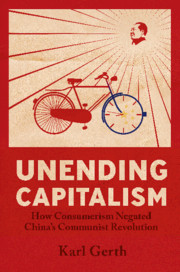Book contents
- Unending Capitalism
- Unending Capitalism
- Copyright page
- Contents
- Figures
- Acknowledgments
- Abbreviations
- Introduction
- Chapter 1 Self-Expanding and Compulsory Consumerism
- Chapter 2 Building State Capitalism Across 1949
- Chapter 3 Soviet Influences on State Consumerism
- Chapter 4 State Consumerism in Advertising, Posters, and Films
- Chapter 5 State Consumerism in the Service Sector
- Chapter 6 Consumerism in the Cultural Revolution
- Chapter 7 The Mao Badge Phenomenon as Consumer Fad
- Afterword
- Notes
- Bibliography
- Index
Chapter 2 - Building State Capitalism Across 1949
Published online by Cambridge University Press: 08 May 2020
- Unending Capitalism
- Unending Capitalism
- Copyright page
- Contents
- Figures
- Acknowledgments
- Abbreviations
- Introduction
- Chapter 1 Self-Expanding and Compulsory Consumerism
- Chapter 2 Building State Capitalism Across 1949
- Chapter 3 Soviet Influences on State Consumerism
- Chapter 4 State Consumerism in Advertising, Posters, and Films
- Chapter 5 State Consumerism in the Service Sector
- Chapter 6 Consumerism in the Cultural Revolution
- Chapter 7 The Mao Badge Phenomenon as Consumer Fad
- Afterword
- Notes
- Bibliography
- Index
Summary
The Revolution of 1949 did not begin the shift to greater state capitalism. Chapter 2 examines the shift toward greater state capitalism in the lead up to and after 1949 by addressing why the CCP decided that facilitating the expansion of industrial production was more important than transforming the social relations of production. In short, military competition required rapid industrialization. Together, the first two chapters show how the CCP built on the pre-existing institutional foundations for the expansion of consumerism. The CCP consistently subordinated the transformation of social relations to the goal of amassing ever greater sums of capital and control over it and tolerated contradictory policies toward capitalists as long as those policies helped facilitate more immediate goals. Two mass campaigns examined illustrate how the CCP instrumentalized class warfare and used it only for greater capital accumulation rather than socialist transformation. Then the final section shows that the same CCP outcome of accumulation over social transformation applies to the countryside.
Keywords
- Type
- Chapter
- Information
- Unending CapitalismHow Consumerism Negated China's Communist Revolution, pp. 41 - 72Publisher: Cambridge University PressPrint publication year: 2020

